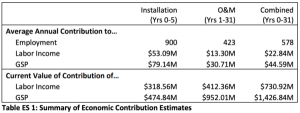In an effort to quantify the overall value that community solar programs could add, the Coalition for Community Solar Access enlisted Michigan State University’s Product Center/Center for Economic Analysis to assess such a program’s economic contributions.
The team, Drs. Steven R. Miller and William Knudson, assumed that the program would enable the installation of 150 MW of capacity per year for six years. The program’s final 900 MW of capacity would be spread out over 30 installations per year, each with a capacity of 5 MW, typical for such installations.

The analysis also assumes the installations would be distributed statewide rather than centralized to a few counties, and that the lifespan of a facility would be 25 years. The study did not consider other value-creating resources, such as energy storage.
The benefits were calculated as additions to Michigan’s gross state product, meaning what they would add to the state’s total annual value of goods produced and services provided. All figures were calculated in current dollars, rather than projected for the future.
Project installation alone was determined to generate $474.84 million in cumulative gross state product. Lifetime operations and maintenance (O&M) expenditures were expected to generate $952.01 million in gross state product. Over the life of the program, the combined discounted contributions to gross state product were estimated to be $1.47 billion.
 Image: Michigan State University, Coalition for for Community Solar Access
Image: Michigan State University, Coalition for for Community Solar Access
Breaking the numbers down into annual terms, the report outlined that the industry-wide construction contribution to gross state product would be $79.14 million for the six years of installation. The annual contributions from O&M averaged to around $30.71 million over the 31-year projections.
The report also projected contributions to Michigan labor income and employment. It calculated an estimated 900 new Michigan jobs per year, with a total of $318.56 million in labor income over the six years of installations.
Aside from construction, the team estimated that 423 annual jobs would be created and linked to O&M operations over the 31-year span. The projected labor income, discounted to current values over this same period, was expected to be $412.36 million.
The current value of expected labor income (both installation and O&M) over the 31-year analysis was $730.92 million. And the current value of future stream of contributions to gross state product exceeded $1.426 billion over the same timespan.
On a per-project basis, a single 5 MW community solar project would directly employ about 15 Michigan workers and support about 30 jobs with a total payroll of just under $2 million. In addition, the analysis estimated that a single 5 MW community solar project would contribute nearly $3 million in annual gross domestic project during the installation phase.






